Unit 7: aspects in English

This Unit will be hard to understand unless you have already worked
through Unit 6 which is concerned (mostly) with the most critical tense
forms.
In that unit, aspect was explained like this:
Aspect is a key concept in understanding English tenses because the
language depends heavily on forms of the verb to signal how the
speaker feels about the tense. We will use two of the most
important aspects of English tense forms to exemplify what is
meant:
- I can, for example, say:
John thinks he is Napoleon
and am making a statement about a present condition.
However, I can also say:
Shush. John is thinking
and now I am signalling the fact that I am talking about an action in progress. That's why it is called the progressive aspect. - If I say:
John has arrived
then what I am saying is that although John's arrival is finished, the relevance of it to the present is clear to me and I want to communicate it. What English has done with this form of the verb is embed a past event in the present to make it clear that the past event has changed the way I view the present.
I might, therefore, go on to say:
... so now we can eat
or express whatever else in the present has been affected by John's past arrival.
This is called the perfect aspect of the tense in English.
There are other aspects which English does not signal with changes
to the verb phrases but which it can express and we will come to
those later.
For now, it's enough to know that other languages handle aspect very
differently and some, such as German, arguably don't bother with it
at all.
Here's the menu and, as usual, clicking on the yellow arrow at the end of any section will return you to it.
| Section | Looking at: |
| A | Primary auxiliary verbs The verbs we use to make aspects and some of their other uses. |
| B | Progressive and continuous aspects And the difference between them. |
| C | Perfect aspects Relating events in time. |
| D | Other aspects. Which are less well known. |
Section A: Primary auxiliary verbs
 |
The verbs |
There are four primary auxiliary verbs and one other arguable
case.
The guide (linked below) to the verbs explains what they all do but here
we are concerned with just two of them:
- The verb be which serves to signal a progressive aspect of a verb and also signals the passive voice (as you saw in Unit 3).
- The verb have which signals the perfect aspect (and also makes a kind of passive called a causative, which does not concern us here).
The other two primary auxiliary verbs are do which, as we saw, is used to form negative and questions forms with the simple present and simple past and get which also makes passive and causatives.
The arguable case is the verb will because as we saw in Unit 6, that verb combines with others to make a future form and also works to show willingness (in which form it is considered a modal auxiliary rather than primary auxiliary verb and discussed in Unit 8).
The forms of main that these two auxiliary verbs combine with are different:
| The verb: | combines with | to make, for example |
| be | the -ing form |
She is going home They are swimming Are we inviting the neighbours? She wasn't working too hard |
| have | the past participle |
I have finished She had arrived by then Have they joined us? He hasn't begun |
(For simplicity's sake here, we are referring to the progressive form with the verb be being following by an -ing form but you may prefer to call it a present participle. It is just that but -ing forms also perform other functions which are not present participles.)
We can also, as we shall see in a bit more detail, combine
aspects like this, for example:
Has she been running?
I have been working on this for two days
We hadn't been enjoying the party up till then
all of which combine the perfect aspect (using have) with
the progressive aspect (using be).
 |
The form |
Both verbs are irregular so learners need to have memorised the
forms before they can make a correct tense structure.
It isn't particularly difficult to do so because, as we note
elsewhere, English is not rich in verb inflexions.
They work like this:
| be + -ing | |||||
| Present | Past | Future | Present perfect aspect | Past perfect aspect | Future perfect aspect |
| I am You are He / She / It is We are They are |
I was You were He / She / It was We were They were |
I will be You will be He / She / It will be We will be They will be |
I have been You have been He / She / It has been We have been They have been |
I had been You had been He / She / It had been We had been They had been |
I will have
been You will have been He / She / It will have been We will have been You will have been |
| have + past participle | ||
| Present | Past | Future |
| I have You have He / She / It has We have They have |
I had You had He / She / It had We had They had |
I will have You will have He / She / It will have We will have They will have |
The perfect forms do not need to be repeated in both tables
because they are, naturally, the same.
In English, when aspects are combined, the perfect always
precedes the progressive so we say, e.g.:
She has been working
not
*She has being worked
Other languages may have different rules.
Learners of English need to memorise the past participle forms of
irregular verbs and be able to form and pronounce the regular forms
(which take -d or -ed).
There is no problem with -ing forms, apart from some simple
spelling changes, because there are no irregular forms in English.
Here is the same table of verb forms that we had at the beginning of Unit 6 but with only the aspectual tense forms included:
| Tense | Main uses | Examples |
| Present progressive | Current events | He is writing a letter |
| Current (background) events which may not be occurring now | He is writing a book He is studying French |
|
| Currently arranged future | I'm seeing the doctor tomorrow | |
| Past progressive | Interrupted past action | I was eating when he rang |
| Progressive action at a particular time | I was eating at 7 | |
| Discontinued or temporary past habit | I was walking to work in those days | |
| Parallel past events or events | It was raining and the wind was blowing
hard I was eating while she was watching television |
|
| Present perfect | A past embedded in the present which changes it | I have spoken to him (so now he
knows) I have learnt French (so now I can speak it) He has broken the pump (so now we can't use it) |
| To describe past experiences which change the present | I have been to America (so I can speak about it) | |
| Present perfect progressive | To emphasise the duration of a long event embedded in the present which changes it | I've been waiting for hours (and am really cold) |
| Events embedded in the present which change it and are still current (this is actually continuous, not progressive) | She's been looking unwell for some time (and still is) | |
| A series of repeated past events embedded in the present which change it | He's been stealing money from his employer | |
| Past perfect | Completed events before others embedded in the past which explain it | I had already spoken to her before he asked |
| Completed long events before others embedded in the past which explain it | It had rained for a week and the garden was muddy | |
| Past perfect progressive | (Un)completed long events before events in the past. A previous event is embedded in a past event | I had been playing chess for two hours before he arrived |
| To show a past result of a previous event. The previous event is embedded in the past event | He had been working too hard and was exhausted | |
| To show a repeated event embedded in a past event | People had been forgetting to come so he sent a reminder | |
| Future progressive | Potentially interrupted action | He'll be working when you come |
| Progressive future event happening as a matter of course at a specific time | I'll be working at 7 | |
| Future perfect | Completed event occurring before another and embedded within it which affects the second | He'll have finished the book by the time I want it |
| To show causal connections between future events | He'll have repaired the car and then we can use it | |
| States occurring before future events (certain verbs only) which change the second event | I'll have been at the hotel for a day or two before I can call you | |
| Future perfect progressive | Future progressive events embedded in later events which alter them | I will have been working for over two hours before you get here |
| To show causal connections between long events and states | He'll have been travelling for ten hours and will be tired | |
| To show a repeated previous event embedded in a future event | I'll have been trying to call him for two hours by then |
We have already dealt with some of the aspects of tenses in Unit 6, so here we will focus on the others.
 |
Learn moreIf you want to discover more now about tenses of all
kinds, go to: |
 |
Take a test |
Try a test which only focuses
on the names of the tenses in the table above.
If you follow any other guides on this site to tense forms, you will
come across plenty more tests.
Section B: progressive and continuous aspects
 |
He's sitting in his office |
You will very often hear (and, alas, sometimes read) the terms
progressive and continuous being used interchangeably.
English, it is true often uses the form of be and the -ing
form together to signal both a continuous state and a progressive
action so we see, for example:
Mary is living in France at the moment
and
Mary is writing a letter to her father at the
moment
However, the meanings are distinct.
In the first case, we can express the same thought as:
Mary lives in France at the moment
because the aspect is a continuous state, not a progressive action.
In the second case, we cannot replace the verb form with the same
effect so
Mary writes a letter to her father at the
moment
is close to nonsense because the progressive aspect is not
signalled by the simple form of the verb and must be shown by be
plus the -ing form.
Many verbs which imply a continuous state are used in the simple
form to refer to a continuous aspect so we find, for example:
She thinks I don't know that
He seems lost
I expect she's the manager
They make shoes here
and so on.
We do not normally say:
*She is thinking I don't know that
*He is seeming lost
*I am expecting she's the manager
*They are making shoes here
because the verb itself signals the continuous state.
Nevertheless, all the correct sentences refer to a continuous
condition so are in the continuous aspect, whatever the verb form.
We have already encountered issues with the stative vs. dynamic
uses of verbs elsewhere.
To repeat what has been said, the continuous aspect may be
signalled by a stative use of a verb but the progressive aspect can
only be signalled by a progressive form using be plus the
-ing form of the main verb.
The progressive aspect can be signalled in all main tenses in
English with exactly the same effect and subject to exactly the same
restrictions concerning the meaning of verbs so we can encounter,
for example:
She had been thinking about the problem (and was
still doing so)
She will be staying with friends (temporarily)
I have been talking to Mary (repeatedly and at
length)
 |
Temporary, background or progressive? |
With most verbs, we signal the progressive aspect by using the
be + -ing form and that works just fine when we distinguish
between, for example:
She's knitting a pullover vs. She knits
pullovers
They're playing cricket vs. They play cricket
We're enjoying the music vs. We enjoy the music
I'm cooking the dinner vs. I cook the dinner
and so on.
However, when we use a verb such as live, work, read, stay
and more whose meaning involves a long-lasting (i.e., progressive)
condition or action, using the progressive form suggests not a
progressive action or state but a temporary or background one.
For example:
She's living in a hotel
They are working abroad
I'm reading Hemingway
We're staying with friends
all imply a temporary or background state and she may not be near
the hotel, they may be sitting at home, I may be in the pub with
friends and we may be in the cinema at the time of speaking.
It matters little which tense is used to suggest this distinction
so, for example:
He has been working in reception
I had been staying in a hotel
I will be staying in Spain
all imply temporary or background events, not progressive ones.
 |
Time lines |
A diagrammatic representation of continuous and progressive
aspects can look like this:
Continuous aspect, simple form:

Progressive aspect (temporary situation):

and like this for true progressive events:

 |
Learn moreIf you want to discover more now about how aspect in
general: |
 |
Take a test |
Try a test of your knowledge of the
three most important aspects.
Use the 'Back' button to return when you have done that.
Section C: the perfect aspect
 |
The sun has nearly set |
In Unit 6, we showed that a sentence such as:
Mary has just arrived
is about the present because Mary's arrival changes what is likely
or possible to happen now. For this reason there is an implied
or stated thought along the lines of:
... so now we can begin / eat / go out
etc.
We said there that the perfect aspect is used to embed one event in
one time in another situation at another time.
All perfect tense forms do this so we find, for example:
The meal had gone cold so I heated it in the oven (embedding
the cooling in the heating actions)
She has been running to get here on time and
is too breathless to speak (embedding the progressive sense of
running in her current state of breathlessness)
 |
The perfect aspect in the future |
| He will have driven for hours |
The future perfect tense is a slight anomaly because it is
usually followed by a clause in the present tense or by a time
adverbial as in, for example:
She will have done the work by the time the
boss gets here
I will have finished the work by then
The new road will have been opened by the end of the year
etc.
It is a characteristic of English (and few other languages) that the
second clause does not carry a future time marker so we do not find
*She will have finished when the boss will
arrive
although that is logically what we should say because both events
are clearly in the future.
Many other languages will do just that and have a future form in
both clauses and that, naturally, leads to considerable confusion
and error.
 |
Time lines |
Time lines are a very useful resource because the perfect aspect
in English is very hard for speakers of languages which do not have
one to understand and get right.
Because the perfect aspect signals a relationship between two times
rather than setting an event, state or action in a single time
frame, it is important to include the eye to show the point of view
of the speaker.
For example, for a simple present perfect use:
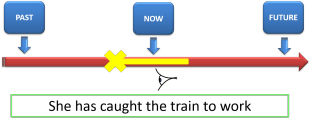
and for a situation in which we want to combine the perfect and
progressive aspects to express a repeated event, we can try:
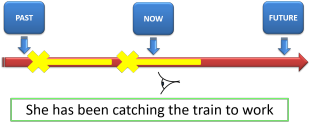
The past perfect is similarly illustrated as:
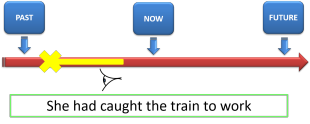
or

The future perfect also requires an eye to show the point of view
because its use involves imagining a later future and looking back
on an earlier one as in:
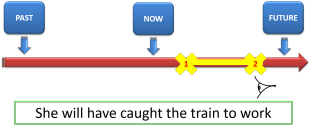
or

 |
Learn moreIf you want to discover more now about how aspect in
general: There is no test on this section but the guide linked above will take you to more information. |
Section D: other aspects
 |
Iterative, durative, prospective and habitual |
In some languages, other aspects are signalled by the form of the
verb, and in some, there are no recognisable aspectual forms at all.
We will briefly deal with four aspects which are clearly present in
English although the verb forms are not recognisably different from
the ones we have encountered in this Unit and in Unit 6.
These are they:
- The iterative aspect
Is one we have alluded to elsewhere here and refers to actions or events which are repeated as in, e.g.:
Banging the drums
Someone has been stealing apples from the garden
She was hitting the laptop keys angrily
They had been throwing a ball about in the garden
As you can see from these examples, when we use a verb such as hit, break, drop, splash, shoot etc. which, by definition, refer to instantaneous events which cannot be continuous states or progressive actions, the use of be + -ing signals repetition. That's the meaning of iterative.
With other verbs which can be seen as continuous or progressive such as play, read, live, walk and so on, the use of be + -ing signals the aspects we encountered in Section B, above. - The durative aspect
Many verbs signal actions which are progressive or continuous so we do not need the be + -ing formulation to imply a long-lasting event so we can say
Working all night
She worked for two hours
and the sense of a progressive action is embodied in the verb.
However, there are times when we want to emphasise the length of an event, state or action and then we can combine these verbs with the progressive aspect form to do so. We also often add adverbials such as all night, for hours and hours and so on to underline our meaning. For example:
The train broke down and we were sitting in the middle of nowhere for ages and ages
The speeches went on for a long time and I was trying hard to stay awake - The prospective aspect
We saw, in Unit 6, that we use a present progressive form (be + -ing) to refer to a current arrangement and the going + to formulation to refer to a current intention.
These can both be seen as prospective aspects of present forms.
Equally, we can put the aspect into the past and have, for example:
I was going to call you but I clean forgot
She had been meeting her friends that evening but found she had to work late
In both those examples, the sense is of a thwarted arrangement or intention and the forms are sometimes referred to as the future in the past. - The habitual aspect

We saw in Unit 6, that used to and would are used for this aspect in English as in, e.g.:
We used to have lunch in the park
She would get worried when I was late home
but we have also seen that expressions such as
I'll be taking the train to work for a while
I've been trying to learn French for years
I'm smoking too much
I always find Monday mornings difficult
and so on are other ways that English has of referring to habits and routines.
There are few dedicated verb forms for any of these four aspects in English but other languages do have special forms to denote the meanings.
 |
Time lines |
We can use time lines to show how English deals with all four of
these aspects.
Here are some examples:
Iterative:

Durative:

Prospective:
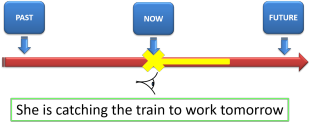
Habitual:
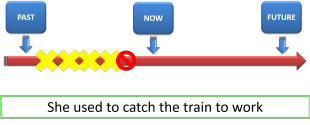
 |
Learn moreIf you want to discover more about aspects in English, go
to either: |
 |
Take a test |
To make sure you have understood so far, try
a test of your knowledge of
all the aspects in English that we have discussed.
Use the 'Back' button to return when you have done that.
